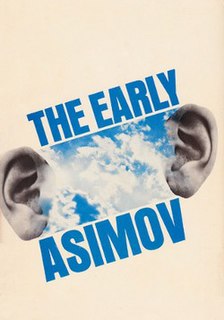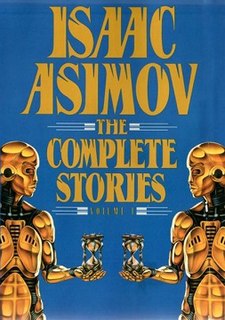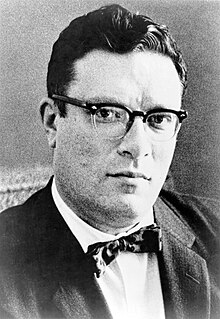
I, Robot is a fixup novel of science fiction short stories or essays by American writer Isaac Asimov. The stories originally appeared in the American magazines Super Science Stories and Astounding Science Fiction between 1940 and 1950 and were then compiled into a book for stand-alone publication by Gnome Press in 1950, in an initial edition of 5,000 copies. The stories are woven together by a framing narrative in which the fictional Dr. Susan Calvin tells each story to a reporter in the 21st century. Although the stories can be read separately, they share a theme of the interaction of humans, robots, and morality, and when combined they tell a larger story of Asimov's fictional history of robotics.

The Robot series is a series of 37 science fiction short stories and six novels by American writer Isaac Asimov, featuring positronic robots.

Gardner Raymond Dozois was an American science fiction author and editor. He was the founding editor of The Year's Best Science Fiction anthologies (1984–present) and was editor of Asimov's Science Fiction magazine (1984–2004), garnering multiple Hugo and Locus Awards for those works almost every year. He also won the Nebula Award for Best Short Story twice. He was inducted to the Science Fiction Hall of Fame on June 25, 2011.

Asimov's Science Fiction is an American science fiction magazine which publishes science fiction and fantasy named after science fiction author Isaac Asimov. It is currently published by Penny Publications. From January 2017, the publication frequency is bimonthly.
"Liar!" is a science fiction short story by American writer Isaac Asimov. It first appeared in the May 1941 issue of Astounding Science Fiction and was reprinted in the collections I, Robot (1950) and The Complete Robot (1982). It was Asimov's third published positronic robot story. Although the word "robot" was introduced to the public by Czech writer Karel Čapek in his 1920 play R.U.R., Asimov's story "Liar!" contains the first recorded use of the word "robotics" according to the Oxford English Dictionary. The events of this short story are also mentioned in the novel The Robots of Dawn written by the same author.
See also: Isaac Asimov bibliography (categorical), Isaac Asimov bibliography (chronological)

"The Last Question" is a science fiction short story by American writer Isaac Asimov. It first appeared in the November 1956 issue of Science Fiction Quarterly and was anthologized in the collections Nine Tomorrows (1959), The Best of Isaac Asimov (1973), Robot Dreams (1986), The Best Science Fiction of Isaac Asimov (1986), the retrospective Opus 100 (1969), and in Isaac Asimov: The Complete Stories, Vol. 1 (1990). It was Asimov's favorite short story of his own authorship, and is one of a loosely connected series of stories concerning a fictional computer called Multivac. The story overlaps science fiction, theology, and philosophy.
This is a list of short stories by American writer Isaac Asimov. Asimov is principally known for his science fiction, but he also wrote mystery and fantasy stories.

The Early Asimov or, Eleven Years of Trying is a 1972 collection of short stories by Isaac Asimov. Each story is accompanied by commentary by the author, who gives details about his life and his literary achievements in the period in which he wrote the story, effectively amounting to a sort of autobiography for the years 1938 to 1949.

"The Immortal Bard" is a science fiction short story by American writer Isaac Asimov. It was first published in the May 1954 issue of Universe Science Fiction, and has since been republished in several collections and anthologies, including Earth Is Room Enough (1957) and The Best Science Fiction of Isaac Asimov (1986). Like many of his stories, it is told as a conversation, in this case between two professors at a college faculty's annual Christmas party.

The Best Science Fiction of Isaac Asimov, published in 1986, is a collection of 28 short stories by American writer Isaac Asimov, personally selected as favorites by himself.

Asimov's Mysteries, published in 1968, is a collection of 14 short stories by American writer Isaac Asimov, almost all of them science fiction mysteries. The stories were all originally published in magazines between 1954 and 1967, except for "Marooned off Vesta", Asimov's first published story, which first appeared in 1939.

The Complete Stories is a discontinued series intended to form a definitive collection of Isaac Asimov's short stories. Originally published in 1990 and 1992 by Doubleday, it was discontinued after the second book of the planned series. Altogether 86 of Asimov's 383 published short stories are collected in these two volumes.

Susan Palwick is an American writer and professor emerita of English at the University of Nevada, Reno. She began her professional career by publishing "The Woman Who Saved the World" for Isaac Asimov's Science Fiction Magazine in 1985.
The Author's Ordeal are lyrics to a song written by science fiction author Isaac Asimov. They were first published in Science Fiction Quarterly, May 1957, pp. 34–36. They are included in three collections of Asimov's short stories: Earth Is Room Enough, The Far Ends of Time and Earth and The Complete Stories, Volume 1.
"The Up-to-Date Sorcerer" is a science fiction short story by American writer Isaac Asimov. It was first published in the July 1958 issue of Magazine of Fantasy and Science Fiction and reprinted in the 1969 collection Nightfall and Other Stories.
Isaac Asimov Presents The Great SF Stories 19 (1957) is the nineteenth volume of Isaac Asimov Presents The Great SF Stories, which is a series of short story collections, edited by Isaac Asimov and Martin H. Greenberg, which attempts to list the great science fiction stories from the Golden Age of Science Fiction. They date the Golden Age as beginning in 1939 and lasting until 1963.

Magical Wishes is an anthology of themed fantasy and science fiction short stories on the subject of wishes edited by Isaac Asimov, Martin H. Greenberg and Charles G. Waugh as the seventh volume in their Isaac Asimov's Magical Worlds of Fantasy series. It was first published in paperback by Signet/New American Library in November 1986. The first British edition was issued in trade paperback by Robinson in July 1987.
Isaac Asimov wrote three volumes of autobiography. In Memory Yet Green (1979) and In Joy Still Felt (1980) were a two-volume work, covering his life up to 1978. The third volume, I Asimov: A Memoir (1994), published after his death, was not a sequel but a new work which covered his whole life. This third book won a Hugo Award.













